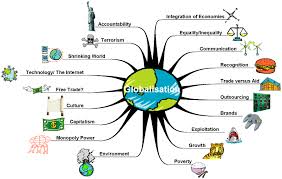Globalization not only affects the lives of indigenous people, but also affects the lives of poor people of the world. Globalization is now a multidimensional topic. There is not a single sector which is not touched by globalization; it has reached out to the far-off people in the remotest corners of the world.. The world became a village, which is called global village. Information technology plays a pivotal role in enhancing the global unity. All of us are very close and we are in a caravan but rich are on the luxurious room and the poor in the deck.
But in this process rich countries and their economic, technological even cultural powers dominate the under developed and least developed countries. By the way of last three decades especially early 90s. we went to the WTO system of free trade zone and in the name of free trade all of our culture and socio-economic patterns now in the way of Globalization. This enlighten in this term paper. Mainly Global system of economic and new world order in the information, communication technology in our economy.
Statement of the Problems:-
Challenges of Globalization :
Bangladesh’s economy grew rapidly during the 1990s as the country liberalized its markets and became increasingly integrated into the world economy .Until the 2001 global recession, Bangladesh ranked third for improvement of human development behind only cape Verde and china thanks in large part to exports from its blossoming garment industry. Bangladesh faces the challenge of achieving accelerated economic growth and alleviating the massive proverty that affects nearly two-fifths of its 140 million people. To meet this challenge, market oriented liberalizing policy reforms were initiated in the mid 1980s and were pursued much more vigorously in the 1990s. These reforms were particularly aimed at moving towards an open economic regime and integrating with the global economy.
During the 1990s, notable progress was hard in economic performance. along with maintaining economic stabilization with a significantly reduced and declaring dependence on foreign aid, the economy appeared to begin a transition from stabilization to growth. The average annual growth in per capita income had steadily accelerated from about 1.6 per cent per annum in the first half of the 1980s to 3.6 percent by the later half of the 1990s. This improved performance owed itself both to a slowdown in population growth and a sustained increase in the rate of GDP growth, which averaged 5.2 percent annually during the second half of the 1990s. During this time, progress in the human development indicators was even more impressive.
While most low-income countries depend largely on the export of primary commodities, Bangladesh has made the transition from being primarily a Jute-exporting country to a garment exporting one. This transition has been dictated by the country’s resource endowment characterized by extreme land scarcity and a very high population density, making economic growth dependent on the export of labor intensive manufactures.
The relatively strong growth of the Bangladeshi economy in the 1990s was underpinned by the even stronger export growth. Unfortunately, the removal of the Multi-fiber Arrangements (MFA) quotas now threaten to increase competition in the global garment industry and thus limit Bangladeshis growth. The strength of the industry depends on the export quotas dictated by the MFA and preferential access in the major western markets. Moreover, other export industries are unlikely to take its place if the garment industry shrinks, excluding the garment industry, the growth of the large scale manufacturing industries was a meagre 4 percent annually in the 1990s. That may partly reflect the overall poor investment climates, but also partly the effect of increased competition from import on industries catering to the domestic market. In such a situation, the desirability of further import liberalization may be put to question since the country depends heavily on imported raw materials, machinery and components, cutting back on imports owned hurt prospects for creating jobs by adversely affecting production and investment activities.
It is not easy for a least Developed country (LDC) like Bangladesh to specialize in manufactured exports. Having low wage Costs can hardly compensate for its lack of marketing skill and infrastructure and poor overall investment climate. Moreover, the high degree of dependence of domestic industries on imported raw materials and industrial inputs makes it difficult for Bangladesh to satisfy the so called ‘rules of origin’ in getting preferential access for its export in the markets of the developed countries. Thus, most of Bangladesh garment eligible for the tariff concessions given under the Generalized system of preferences (GSP) in the EU Market. This problem has not received adequate attention, since the other major players in textile trade among developing countries are hardly affected by it.
Objectives
This study has been undertaken with the following objectives:
- To identify the impact of Globalization on our economy, culture & ICT sector
- To show the impact of global culture on our young generation.
- To frame recommendations to prevent the bad effect of Globalization.
Scope of the term paper
My research has led me to read a good number of books, articles, and journals – both local and foreign.
Globalization is a modern concept which encompasses many areas of our life and culture. Our allotted time was too short compared to the concerned issues that were needed to be studied. Still I have tried to give my best efforts to study in a proper fashion.
Methodology
This study was based on secondary data collected from published sources of various national and international agencies. The main source of data was various publications of the government of Bangladesh UNDP report. Bangladesh Economic Review was one of the important sources.
Definition
Globalization is a term that has come to be used in recent years increasingly, frequently and loosely. It is a complex process that has been going on for centuries since the advent of large scale international trade and rapid communications. As a force that links people around the world in increased trade, investment, technology, education, information and communication, Globalization affects booth domestic and international affairs of the countries. Today the internationally dispersed socio-politic-economic activities are being transformed into an integrated one. However, globalization has brought a mixture of effects on national economy, politics, Society, ecology, and family of a developing country like Bangladesh.
Limitation of the study
Time constraint was main drawback in collecting information about the subject matter. There was also shortage of enough books and journals concerning the matter. Up-to-date information was not available in NAEM library. As there is not enough time to research on the topic within the limited time and source, I am afraid some information might be left out and it might also happen that the scenario presented here is less than convincing
Globalization & Bangladesh Economy
Globalization has heightened the role of trade in world economy and made industrialization an integrated system of global trade and production. There has been an unprecedented expansion in world trade almost 30 fold in the last three decades. In fact, nearly all industrialized countries of East and Southeast Asia increased their manufactured exports to the tune of one tenth of the industrialized countries of the North. Most of these countries also shifted to high value added production in the 1990s which at the same time witnessed countries at the lower level of development such as Bangladesh, Pakistan and Sri Lanka to make clothing exports a growth pole for them, earning more than one billion dollar annually. Thus most countries are now significant exporters and are connected to global commodity chain through which they supply goods and services in the world economy. It is also interesting to note that the sustained growth of trade among countries and between regions has been happening despite serious problems in current trading arrangements.
(a) Bangladesh and WTO :
WTO is the main organization which is playing a pivotal role to connect the world in trade. Since the establishment of WTO on 1 January 1995, Bangladesh has been playing an active role in on-going WTO negotiations with a view to protecting the legitimate claim and interest of LDCs in an extremely competitive global trading environment. Bangladesh also attaches equal emphasis on its bilateral and regional trade.
To protect the interest of LDCs, Bangladesh has been strongly pleading for duty-free and quota free market access for all products originating from LDCs, exploring employment opportunities for the semi-skilled labour force abroad, enhancing market share for LDCs in the global trade, meaningful and effective trade related technical assistance, exemption of LDCs products from any anti-dumping, countervailing and safeguard measures, implementation of all special and differential treatment provisions for LDCs, continuation of domestic support for low income and resource poor farmers and subsidy for internal and international transport and freight charge with a view to reducing marketing cost and developing trade remedial measures and compensatory mechanism to address the erosion of trade preferences etc.
Along with other WTO members, Bangladesh has been playing an important role to bring WTO negotiations back on track after the “Cancun” setback in September 2003. The sixth WTO Ministerial conference was held in Hong Kong from 13-18 December, 2005. The major negotiating issues were Agriculture, NAMA (Non-Agriculture Markert Access) services, WTO Rules, Trade Facilitation, Aid for Trade and specific development issues for LDCs. The main demand of LDCs was to get duty free and quota free market access to the developed & developing countries declaring themselves in a position to do so. The issue was particularly important for LDCs including Bangladesh to raise their market share in the global trade. At Present, LDCs market share in the world export trade is about 0.6 percent. Besides, some other achievements of LDCs including Bangladesh are as follows.
- Rule of origin will be simplified so that LDCs can avail themselves of the market access facilities.
- LDCs have been given an extension of the transition period until 1 July, 2003 to provide protection for trade marks, copy rights, Patents and other intellectual property under the TRIPS Agreement. Earlier, an extension of the transition period for Pharmaceutical products was granted for LDCs until 1 January 2016. This has been extremely helpful for the expansion of export.
- LDCs will not be required to make commitment particularly under trade facilitation to the extent consistent with their individual capacities.
- LDCs including Bangladesh have been allowed to maintain “Temporary Investment Measures up to 2020, if needed. In that case there will not be obligations under the TRIMs Agreement.
- LDCs will be given technical and financial support under the integrated frame work, technical co-operation and aid for trade package.
Meanwhile, the government has already spelt out its “market access strategy” with a view to reaping the meaningful benefit from the Hong Kong Declaration.
(b) Composition of Import & Export in Bangladesh:
Government has already spelt out its market access strategy to face the challenge. But what is the result? Here is shown the Import & Export scenario for the last three years. Here is shown the negative balance which is as follows.
Composition of Import & Export (Figure in million US dollar)
Year | Export | Import | Balance |
2003-2004 | 7,602.99 | 10,903.00 | 3,300.01 |
2004-2005 | 8,654.52 | 13,147.00 | 4492.48 |
2005-2006 | 10,526.16 | 14,746.00 | 4,219.84 |
(c) Scenarios in Telecommunication Industry where competitors are foreign companies :
There is a radical change in our telecommunication Sector. We can easily understand what will happen when we will be fully connected to the global village. Four private (cellular) mobile companies are operating competitively. The number of subscribers of the four private mobile operators is expected to exceed 20 million from the present 14.20 million (June 2006) in the next one year. To meet the increasing demand for telephone, BTRC generated Mobile Telecom operator license to BTTB, which was subsequently revised to form a separate entity under the name of TeleTalk and has already become operational. On the other hand another 15 companies have been awarded licenses for providing fixed phone services in a competitive environment. In June 2006 the number of customers of five mobile phone companies is presented in the following graph.
Cell phone subscribers in Bangladesh
| Grameen Phone | 84,67,000 |
| Aktel | 25,05,664 |
| Banglalink | 23,13,900 |
| City cell | 6,86,494 |
| Teletalk | 2,35,255 |
In this connection we can see the positive and negative impact in our economy. The positive impacts are as follows
(1) Employment opportunities have been opened up for thousands of the unemployed.
Mobile phone call charges are decreasing, which is now below TK 2.00 per minute.
On the other hand, a huge foreign currency is going abroad because maximum share holders of the companies are foreigners. Exception is Teletalk. But a few subscribers are provided by TeleTalk. It is mentionable here that this year another foreign company Warid has started since January but here is shown the date up to June 2006. That is why Warid is not seen in this chart.
(d) Foreign Investment in Bangladesh : In global Context :
Bangladesh is a small but overpopulated poor country. A huge number of unemployed people are the main problem in our economy. So we need more investment so that this investment can provide them. Doing Business in Bangladesh today is easier than in many developing economies. A report entitled “ Doing Business in 2006 : Creating Jobs” Published Jointly by the World Bank and IFC ranked Banglalink in the 65th position in terms of Ease of Doing Business among 155 economics.
Ease of Doing Business Ranking (selected)
Rank | Country |
1 | New Zeland |
20 | Thailand` |
31 | Maldive |
55 | Nepal |
60 | Pakistan |
65 | Bangladesh |
75 | Sri-lanka |
91 | China |
99 | Vietnam |
104 | Bhutan |
116 | India |
122 | Afganistan |
Investment Statistics : FDI
Foreign Direct Investment has long been recognised as an important channel of capital and technology flows from developed to developing countries. Trends in Foreign Direct Investment are as follows.
(e) Growth in Manufacturing GDP:
Manufacturing has shown a double-digit growth (10.45%) in FY 2005-2006. Because of this robust growth, manufacturing has now turned out to be the single largest contributor to GDP (17.05%) and has overtaken agriculture (16.91%). This clearly shows that the economy of Bangladesh has been transforming quickly from agrarian to industrial structure. The trend in manufacturing growth since 2002 is as follows.
Trend of Structural Transformation of Board Sector Shares in GDP and growth Rate at Constant prices (Base year : 1995-96)
| Share (in percent) | ||||||||
| Sector | 1980-81 | 1985-86 | 1990-91 | 1995-96 | 2000-01 | 2003-04 | 2004-05 | 2005-06 |
| Agriculture | 33.07 | 31.15 | 29.23 | 25.68 | 25.03 | 23.08 | 22.27 | 21.77 |
| Industry | 17.31 | 19.13 | 21.04 | 24.87 | 26.20 | 27.96 | 28.31 | 29.01 |
| Service | 49.62 | 49.73 | 49.73 | 49.45 | 48.77 | 49.22 | 49.42 | 49.22 |
| Total | 100.00 | 100.00 | 100.00 | 100.00 | 100.00 | 100.00 | 100.00 | 100.00 |
| Average growth rate (in percent) | ||||||||
| Agriculture | 3.31 | 3.31 | 2.23 | 3.10 | 3.14 | 4.09 | 2.21 | 4.49 |
| Industry | 5.13 | 6.72 | 4.57 | 6.98 | 7.45 | 7.60 | 8.28 | 9.56 |
| Service | 3.55 | 4.10 | 3.28 | 3.96 | 5.53 | 5.66 | 6.36 | 6.47 |
| GDP (At producer prices) | 3.74 | 3.34 | 3.24 | 3.47 | 5.41 | 5.82 | 5.93 | 6.91 |
Source : Bangladesh Bureau of Statistics (BBS)
Though there is a trend of transformation of the share of agriculture and industry sector over the last two decades, the share of service sector remained constant for the same period except minor variation year to year. The share of agriculture sector in GDP at the beginning of eighties (1980-81) was 33.07 percent which reduced gradually to 29.23 percent in 1990-91 and 25.03 percent in 2000-01. In the current fiscal year, this share stood at 21.77 percent. On the other hand, the share of industry sector in GDP at the beginning of eighties was 17.31 percent which gradually increased to 21.04 percent in 1990-91 and 26.20 in 2000-01. In the current fiscal year, this share is 29.01 percent. This structural transformation of GDP of Bangladesh reflects the positive trend of industry sector both in terms of share and growth. By analysing the sector-wise growth rate within this period, it is observed that industry sector shows significant success in increasing growth compared to agriculture and service sector
Overseas Employment :
A sizeable number of Bangladeshi professional skilled, semi-skilled and unskilled labour force is employed in different countries including the Middle East Overseas employment and workers’ remittances contribute significantly to the economic development of the country through reduction of unemployment and augmenting foreign exchange reserves and income.
Globalization and Culture :
Globalization can both increase and reduce cultural diversity. It increases diversity as foreign cultures are introduced by the power of communications and marketing and by immigration. It reduces diversity if a foreign culture displaces local culture. Both these effects are and can be problematic.
(a) Globalization increases diversity :
Globalization increases social diversity as foreign cultures enter a society and co-exist with local culture. people become aware of different life styles through trade. For example, as Russia has opened its economy the Swedish retailer IKEA has introduced Scandinavian style to consumers in Mascot, but this has not driven out Russia style. People also become aware of different lifestyles through immigration In Britain the “chicken tikka” introduced by South Asian immigrants has become the most popular fast food, but has not driven out fish & chips.
Greater cultural and ethnic diversity can make a society more dynamic, but it can also create problems. In popular perception, diverse societies find it harder to co operate and are more prone to violent conflict. There is evidence that within local communities such as cities in the USA or school boards in Kenya-co-operation is more difficult if the community is multiethnic Many relationships depend upon trust, and cultural diversity can make trust more difficult, These adverse effects of diversity were sufficiently important to affect national economic performance.
(b) Cultural Development in Bangladesh :
Cultural Progress and human development are closely linked to each other in any society. the Stage of cultural development influences the course of progress of the society.
To build up infrastructure of cultural development in line with the course of cultural progress in the world context Bangladesh shilpakalaAcademy, Bangla Academy, National Museum, Nazrul Institute, Folk Arts and crafts foundation, Cox’s Bazar cultural centre, Tribal Cultural Institutes in Rangamati, Banderban & Birishiri etc. are engaged in promoting cultural development under the Ministry of cultural affairs. Already Bangladesh culture has taken a foothold on the world stage. Bangladesh has signed cultural pacts with 39 countries of the world to augment the level of mutual friendship and understanding. Many exchange visits of cultural teams, Students, scholars, cultural Personalities are taking place under cultural exchange programmes. Performance and exhibition programmes of music dance. paint works, handicrafts.
The National Theatre Bhavan with 750-seat theatre hall and a 300 seat experimental Hall have been built in the premises of BangladeshShilpakalaAcademy at Segunbagicha Dhaka with the objective of promoting drama. music and dance. Construction work of National Music Dhaka Centre and National Art Galary Bhavan are also about to be completed. Tribal cultural Institites at khagrachari, Moulavibazar and Rajshahi, LalanAcademy in Kustia have been completed. BanglaAcademy has published many books Promoting higher education, literature and folklores. BanglaAcademy and National Book centre are jointly organising book fairs at National levels.
Success in human development that Bangladesh has achieved has been duly reflected in Human Development Report of 2004, 2005 & 2006 published by UNDP-Bangladesh has been able to place it self among the “Medium Human Development” Category of countries like India, Sri-Lanka for three consecutive years. Adoption of realistic programmes for human development and poverty alleviation and their implementation has brought this success. In the report prepared for the least developed countries 2004 in the conference of the United Nations commission for trade & development (UNCTAD), Bangladesh has been created and has already achieved two targets of the MDGs i.e. in respect of removing inequality between men and women in education and providing for safe drinking water for the populace.
Bangladesh is also expected to be able to achieve the other Millennium Development Goals aimed at ensuring human welfare.
Trends of Human Development Index among SAARC Countries
| Countries | 1975 | 1980 | 1985 | 1990 | 1995 | 2000 | 2002 | 2003 | 2004 |
| Bangladesh | 0.345 139 | .364 139 | .389 139 | .418 139 | .452 139 | .506 139 | .509 138 | .513 139 | .530 137 |
| Bhutan | – | – | – | – | – | – | 134 | 134 | 135 |
| India | .412 127 | .438 127 | .476 127 | .513 127 | .546 127 | .577 127 | .595 127 | .602 127 | .611 126 |
| Maldives | – | – | – | – | – | – | .752 84 | .745 96 | .739 98 |
| Nepal | .6 136 | . 136 | 136 | 136 | 136 | 136 | 148 | 136 | 138 |
| Pakistan | 135 | 135 | 135 | 135 | 135 | – | 142 | 135 | 134 |
| Srilanka | 93 | 93 | 93 | 93 | 93 | – | 96 | 93 | 93 |
Tends of HDI Index of Bangladesh
It is social before that cultural progress and human development are closely linked to each other so it would be evident from the above table that most of the SAARC countries witnessed positive trends in human development over the last three decades. It is heartening to note that Bangladesh has further improved its position in HDI rank from 139 to137 as well as increased HDI values consistently the years as reported by the various Human Development Report published by UNDP.
(c) Globalization reduces diversity :
It is said that if you wants to destroy a nation, destroy their culture. It is a burning question that what is the global impact on culture and what about our Next generation? Cultures differ and the members of a culture have a strong interest in faring their own culture on to the next generation. For example, Bisin and vardier describe the considerable efforts that ethnic minorities devote to the inter generational transmission of culture globalization can threaten this transmission, exposing youth to different cultures through the spread of ideas, goods & advertising and through movement of peoples. Cultural transmission can withstand diversity, co-existing with other cultures in the same society. Obviously, what it can not withstand is a situation in which imported culture is so powerful as to displace local culture. There are well based fears that globalization will weaken the inter generational transmission of culture as a result of displacement effects.
The most likely displacement effects may be for local culture to be displaced by western culture and in particular by American culture. American films and brands have a large presence in the world economy. Both developing and developed countries see a danger of cultural homogenization and consequent loss of identify. The perception of the danger is real and strong by felt. Some countries subsidize their film and culture industries which are permitted under WTO exceptions for products with a high cultural content. But there is no simple answer to this concern and it is clearly a factor in countries decision making concerning integration with the global economy.
(d) The changing Scenarist in cultural area :
In this context a questionnaire was prepared & accordingly supplied to the participants of 90 FTC. the results are as follows
In order to trace out the impact of satellite channels on our fellow-colleagues, the highly educated section of people, I prepared a questionnaire and conducted a survey among the participants of 90 FTC at NAEM. On the while 2 percent of them watch BTV, 40% local private channel. 30% Indian channel, 5% very few viewers have interest in Bangladesh movies, while about 73% viewers enjoy watching Bangladeshi drama are serial. Among music lovers 55% listeners prefer to enjoy modern song, 20% love Rabindra and Nazrul Sangeet, the lovers Hindi song constitute 25% of the total music lovers sadly enough, the appreciation for polli, lalon geeti is on the decline and has very little influence on our younger generation. No wonder most people of younger generation are all favour pop-& band music and Indian and western songs are also equally poplars.
Globalization in ICT Sector of Bangladesh
The advancement of Information Communication Technology makes the vast treasure of all forms of knowledge, information, inventions, methodologies, techniques, process and technologies from the entire global available to us by accessing via internet. It is hopeful for us that information technology already made inroads into our society, indeed into our psyche, for all its economic backwardness, Bangladesh has easily taken to the IT world. However, like many other developing countries, diffusion of information technology (IT) is being severely restricted in Bangladesh because of poor telecommunication infrastructure, limited fixed time access, unreliable conductivity and inadequate bandwidth. So it will require some innovation from our part to take advantage of this vast knowledge base.
Information Communication Technology encompasses the generation of contents, processing, manipulation, storage, routing, transmission, switching, packaging and usage of information to assist our day to day business. Faster processor like Pentium iv, smarter software packages, high speed transmission and routing capabilities with submarine cable for example, help us to take the optimum benefit from this `Global ocean of knowledge, that match our everyday need. The knowledge from all the global sources are stored and continuously being up-to-date in thousands of servers which are interconnected via a net-work with very high speed transmission and switching capability called internet.
(a) Present State of ICT in Bangladesh :
The use of computer started in Bangladesh in 1964 when the Atomic Energy commission installed a multiframe computer. computers began to be used commercially from mid 1980s and since then it has traveled a long way and the last few years in particular have witnessed tremendous advancement in the use of computers.
Due to government incentives like exemption of duties, a vibrant hardware market has developed in Bangladesh and the prices of hardware have come down substantially over the last few years. This trend helped in rapid expansion of ICT use in business and also at the household level.
With deregulation of VSAT, an rapid growth of ISP services took place in recent days. At present there are some 61 internet service providers in the country with VSAT Connectivity mostly through Hong KongSingapore.
All the ISPs are in the private sector and provide a range of internet services like e-mail, browsing, chatting PC to PC call, net to phone, e-mail to fax etc. Today cyber cafes have mushroomed in Dhaka and some other majors cities like Chittagong and Sylhet where young people have become the regulars.
The BTTB & the state owned telecom company “Tele-Talk” have also started providing ISP services the years back.
In here we can see the comparative data of ISP user in Asian SAARRC Countries. (year 2005). The base year of data is 2005.
ISP user in Asian Countries
| Bangladesh | – | 1.5 lakh |
| India | – | 50.00 lakh |
| Sri-Lanka | – | 5.00 lakh |
| Malaysia | – | 35.00 lakh |
| Philipiness | – | 20.00 lakh |
| South Korea | – | 2.68 krore |
(b) Bangladesh in information super Highway :
International Telecommunication system of Bangladesh was dependent on Satellite which was slow and having narrow band width.
According to Telecommunication policy of the government, International Telecommunication network system is being regulated by BTTB. Bangladesh has been connected with high speed submarine cable consortium called SEA-ME-WE-4 to facilitate economical modern telecommunication and low price ICT services. Laying of Error! Not a valid link.-4 submarine cable was completed in December 2005 and has been operating since May 2006.
With the use of submarine cable activities surrounding information and communication technology will be steeped up rapidly in the country. The upcoming generation next will get unhindered access to the information super highway and it will also augment new employment opportunities in the country.
(c) Telecommunication & Bangladesh :
For modernization, improvement and extension of a telecommunication system of the country, government has taken a series of initiatives. Mobile phone service from the public sector installed under the project titled ’10 lakh T & T mobile phone (2.5 lakh in the first phone) a separate company named “Teletalk” has already been established to operate the mobile phone services. We can see a huge number of subscribers are using all phones @ Tk. 2 per minute at present. Here it is mentionable that a big amount of foreign investment has been invested in this sector; accordingly a huge number of unemployed manpower also have been provided in this sector.
After June, 2006, 1,53,17,303 subscribers are using either fixed phone or cell phone. It is a radical change in our telecommunication sector . This figure is increasing day by day significantly & Bangladesh is getting connected with the global village rapidly. We can see in the graph given below.
Phone user in Bangladesh
Year | – | Total Subscribers |
2001 | – | 12,27,348 |
2002 | – | 18,22,394 |
2003 | – | 26,24,490 |
2004 | – | 49,82,067 |
2005 | – | 1,03,59,267 |
2006 (June) | – | 1,53,17,303 |
(d) Bangladesh : Goal the establish a Hi Tech Park :
To provide modern infrastructure and administrative support services and to create an efficient working environment for the development of information Technology, electronics, telecommunications, engineering & other knowledge based industries, government has planned to establish a Hi Tech Park in the country at a cost of TK 25 core.
Currently more than 50 soft ware & IT Service companies in Bangladesh are exporting software and their services to the different countries which include USA, Uk, Australia Canada, Denmark, KSA, Japan, Sweden, UAE Germany, Italy, Netherlands, Norway, Nepal, France etc. Some important users of Bangladeshi software are Nokia, Japan Airlines, World Bank, US Postal Department and Us Department of Agriculture. To meet the growing need of skilled IT professional at home & abroad in the Bangladesh Korea Institute of Information and communication Technology (BKIICT) has been established in the ground floor of BCC Bhavan in Bangladesh with the technical assistance from Korea.
Export statistics of data processing, computer consultancy and computer software during 2000-01 to 2004-2005.
FY | Data Processing | Computer consultancy | Computer software | Total computer service |
2000-01 | 7.88 | 4.21 | – | 12.09 |
2001-02 | 7.76 | 2.10 | 6.18 | 16.04 |
2002-2003 | 9.33 | 3.09 | 11.90 | 24.32 |
2003-2004 | 11.47 | 2.06 | 28.83 | 42.36 |
2004-2005 | 12.69 | 5.99 | 59.29 | 77.97 |
Total | 49.13 | 17.45 | 106.20 | 172.78 |
Findings :-
The growth of industrialization his significantly contributed to the increase of GDP, but still we are jesting consistently more dependent an import because the growth GDP and the increasing size of population do not correspond. unfortunately, we have not been able to downsize our population in a proportional way.
1. Our import growth is higher than export growth. That is why the balance of trade is increasing in negative way.
2. Industry sector shows significant success in increasing growth compared to agriculture & service sector.
3. Our investment climate is better than India Sri-Lanka, Bhutan, Vietnam, China. We are in middle position out of 155 countries, that is why our foreign investment is increasing subsequently.
4. We are in efficient with the competition of other foreign companies.
5. Bangladesh has developed significantly in HD that is a positive sign of cultural development
6. Aggression of foreign culture in our young generation is a bad sign of global Culture..
7. Bangladesh has a great opportunity to play a vital role in ICT Sector.
8. ICT sector has already started to contribute to the economic growth in Bangladesh.
Recommendation
1. Our external relation department should be more effective & technically strong to face any economic diplomacy.
2. More investment should be ensured.
3. Manpower (Skill & unskilled) Export should be enhanced.
4. Must strive to avoid conditional foreign aid.
5. Sustainable technological know how should be adopted in industrial sector.
6. State owned enterprise should outshine beside private & other enterprises.
7. Steps must be taken to instill a strong sense of patriotism and moral values into the budding minds at school and college level.
8. Must promote our age old tradition and culture and our children must be given a solid foundation a govt. traditions and culture.
9. Infrastructural change must be brought about to facilitate the growth of information and communication sector (ICT).
Conclusion
It is practically impossible for Bangladesh to sty away from the process of globalization since the whole world is getting involved in it. But again it would be a real challenge for us to take advantage of this liberal economic policy without massive infrastructural change and significant increase in efficiency level in all sectors. Still Bangladesh enjoys the benefits of being a member of least Developed countries. But before long this special privilege will not be in effect and many third world countries will pose a threat for Bangladesh. For instance, our garments sector will face serious Competition from the garments sector of china since china can ensure better infrastructural support and better trained human resource. Definitely cheap labour and conducive climatic condition are two advantages for Bangladesh. But political stability and good governance must be ensured before we hope to cope with the extremely competitive environment of a globalized world.
















